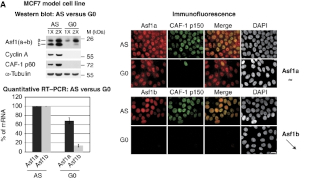TPR is required for cytoplasmic chromatin fragment formation during senescence
Bethany M Bartlett, Yatendra Kumar, Shelagh Boyle, Tamoghna Chowdhury, Andrea Quintanilla, Charlene Boumendil, Juan Carlos Acosta, Wendy A Bickmore
In eukaryotic cells, the genetic material - the DNA, stored in the nucleus is facing two major challenges: (i) there are different subcompartments in the nucleus (ii) it is organized as a nucleo-protein complex in the form of chromatin. These two levels can potentially contribute to modulate all genome functions.
Our lab is interested in understanding how these two levels of nuclear architecture (nuclear compartments and chromatin organization) cooperate to allow the regulation of DNA functions such as DNA repair or gene expression. As an example, while the nuclear lamina usually associates with compact chromatin, called heterochromatin, the nuclear pores are always devoid of heterochromatin association. We recently showed that nuclear pores density increase can trigger major chromatin rearrangements during cellular senescence, which correlates with the expression of a specific inflammatory gene network.
We use a variety of approaches including cellular and molecular biology, advanced imaging methods and synthetic biology in various cellular models, including cellular senescence and mouse embryonic stem cells.
More specifically the questions we currently ask in the lab are:

Figure 1- The nuclear pores and the nuclear lamina are two distinct nuclear compartments forming the nuclear envelope. While the nuclear lamina associates with compact heterochromatin, the nuclear pores are always devoid of heterochromatin association.
Bethany M Bartlett, Yatendra Kumar, Shelagh Boyle, Tamoghna Chowdhury, Andrea Quintanilla, Charlene Boumendil, Juan Carlos Acosta, Wendy A Bickmore
Nobari P, Doye V, Boumendil C
Gabrielle Olley, Madapura M. Pradeepa, Graeme R. Grimes, Sandra Piquet, Sophie E. Polo, David R. FitzPatrick, Wendy A. Bickmore, Charlene Boumendil
Deniaud E, Lemaître C, Boyle S, Bickmore WA
Lemaître C, Bickmore WA
Lemaître C, Soutoglou E
Lemaître C, Grabarz A, Tsouroula K, Andronov L, Furst A, Pankotai T, Heyer V, Rogier M, Attwood KM, Kessler P, Dellaire G, Klaholz B, Reina-San-Martin B, Soutoglou E
Theil AF, Nonnekens J, Steurer B, Mari PO, de Wit J, Lemaitre C, Marteijn JA, Raams A, Maas A, Vermeij M, Essers J, Hoeijmakers JH, Giglia-Mari G, Vermeulen W
C Lemaître, B Fischer, A Kalousi, A-S Hoffbeck, J Guirouilh-Barbat, O D Shahar, D Genet, M Goldberg, P Betrand, B Lopez, L Brino & E Soutoglou

Corpet A, De Koning L, Toedling J, Savignoni A, Berger F, Lemaître C, O\'Sullivan RJ, Karlseder J, Barillot E, Asselain B, Sastre-Garau X, Almouzni G
De Koning L, Savignoni A, Boumendil C, Rehman H, Asselain B, Sastre-Garau X, Almouzni G
Pankotai T, Hoffbeck AS, Boumendil C, Soutoglou E